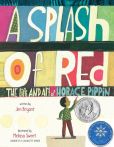 Most of you know I've been working on a picture book biography, and I'm finished with the story part and have been polishing up the back matter. Thank God for back matter! Do you know why? Well, I spent probably 2 1/2 - 3 months of research on this person; my Evernote online notebook is full and so is my real hard copy notebook. But when I revised and revised this story, I had to cut out many facts and areas of this person's life. It was extremely painful. All those months of digging up these gems of facts and anecdotes, only to ditch them. But wait...those facts aren't gone forever. I can use them in my back matter or save them for a future web site spot for students and teachers. Relief!  So exactly what belongs in the back matter? I've been studying the pros, and the sky's the limit. Each book is unique in how its handled. Some leave a small author's note explaining how they were connected with the subject. Others leave 2-3-4 pages of additional information. Here are some examples: In Noah Webster and His Words, the story stops on page 29. A double-spread timeline takes up pages 30-31, and on page 32 is more about Noah's life, and a bibliography divided into primary resources, secondary resources, and web sites. In A Beam of Light, there are 14.5 spreads of story, then one double-spread with the author's note, four sections of additional information about Albert Einstein, and then books for further reading, plus one web site. A Splash of Red includes 5 pages of back matter! The first page has a historical note (more info about Horace Pippin) plus his real photograph. The next spread includes the author's note, illustrator's note, a list of books for further reading, a film, web sites, quotation sources, and an acknowledgements section (thanking everyone who helped with the book including museum people). The last spread in the back matter is a map of places to find Horace's art. Who Says Women Can't Be Doctors has a double spread with the author's note of more about Elizabeth Blackwell and sources used.  Vintage Scissors Vintage Scissors Wow. The back matter is no simple matter! I think the more you have to offer the editor is better. And then the editor can choose what to use. I've already written a short author's note of how I'm connected with my subject, additional information about my subject (mostly those facts I had to cut out of the original story), a timeline, and a bibliography separated by primary and secondary sources. Perhaps I should slim the sources down for "further reading" for children. I also have a list of photographs in public domain that might be helpful to the future illustrator. I realized all this back matter must fit within the confines of a 32 page picture book unless the publisher decides on extra pages. Oh no! Perhaps more cutting. If you want to read more about back matter, I found a few posts. "Today's Picture Book Biographies: Back Matter Matters," The Horn Book. "How to Handle Picture Book Back Matter During Submission" Dear Editor.com (read the comments, too) "Beautiful Back Matter," INK (Interesting Nonfiction for Kids) web site What are your thoughts? What do you think should be included?
16 Comments
3/31/2014 06:04:15 am
I just finished my back matter, Tina. Good to be reminded that we need to stay within the 32 page layout. Thanks for the links below. I'll check them out!
Reply
3/31/2014 09:51:19 am
Tina...what an important post this is! I had never thought about doing children's NF...but recently, maybe because I see so many involved in it, I've had a couple of story sparks...and now have 3 ideas I'd love to pursue. I really appreciate how you examined the topic of back matter...and the links look great. Thanks for an awesome piece. :)
Reply
3/31/2014 10:34:01 am
Thanks for the great post Tina. It's such an important reminder when your are working on NF, especially biographies.
Reply
3/31/2014 12:30:38 pm
A very nice analysis of the sample books regarding back matter, Tina! Tammi Sauer critiqued one of my fiction stories in which I added just a little bit of back matter to explain a couple of things and she was all excited and said that back matter is always good, so I guess it's something even those who aren't nonfiction writers should keep in mind. :)
Reply
3/31/2014 11:12:37 pm
This is a really interesting (and timely) post for me, Tina. I had to do a complete rewrite of my back matter after some critique group feedback. My back matter was too depressing! I had to remind myself that kids don't care if someone is buried in an unmarked grave. (Yes, I had included that...shakes head in shame.) I love your point that additional information can be included on the author's Web site. You've just made some of my rewriting a lot easier.
Reply
4/1/2014 10:32:10 am
Tina, thank you for sharing all about back matter. Another of your posts I'll be keeping for future reference. :-)
Reply
5/6/2014 03:54:19 pm
Likes substantially increase the recognition within your website page and together with the proper range depend; many folks will very likely be drawn to your account. The businesses that offer these products and services, will supply you with non-automated or robotic likes and provide you with severe Instagram likes. The great detail referring to this is that they are instantly sent to the account this means you wouldn't have to attend that a great deal. And when you're a business organization, growing your Instagram likes will be useful.
Reply
11/9/2016 08:15:14 pm
Hi Tina,
Reply
Leave a Reply. |
Tina M. Cho, children's authorI'm a children's author and freelance writer for the educational market. Welcome! Archives
March 2024
Categories
All
|




 RSS Feed
RSS Feed
